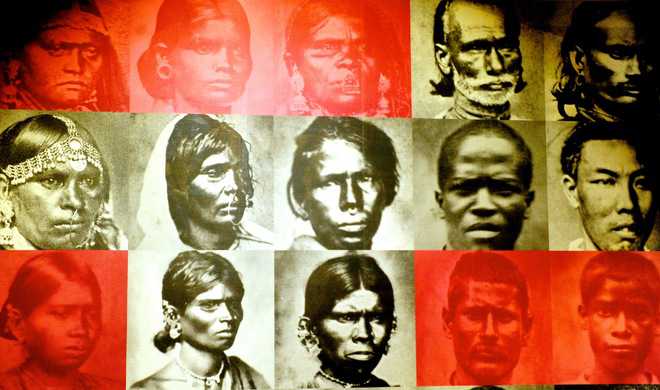
Tracing the slave route: Photographs of indentured labourers at Apravasi Ghat, a Unesco World Heritage Site in Mauritius.
Preeti Verma Lal
At the foothill of Mauritius’ Le Morne mountain, he stands defiant. In his large, hollow eyes, sadness is jumbled with fury. His chest is bare, his shackles broken. Amid the grass, the carved cast iron stands nameless. Another man with a curly mop sits looped on a beige stone. Grief and helplessness peep from his closed eyelids. He, too, has no name. He, too, sits in the shadow of the Le Morne Mountain, which has been home to countless African fugitive slaves (also called maroons) who between 1730s and 1830s escaped from oppression and drudgery of working on British-owned sugar plantations to hide in the wooded, inaccessible cliffs.
Their fate would have turned on February 1, 1835, when the British administration abolished slavery. A platoon of British soldiers marched up to the mountain top to convey happy tidings. Seeing the soldiers approaching, the slaves — men, women, children — threw themselves off the cliffs to their death below. Freedom had come their way, but the slaves unknowingly embraced death.
The Le Morne Monument, a Unesco World Heritage List, pays homage to the maroons and is considered as the Mauritius’ Cultural Landscape. The history of slavery in Mauritius is commemorated annually on August 23, Unesco’s International Day for the remembrance of the slave trade.
In Mauritius, there were not the only the ‘slaves’ one met. There was Soorop, Sabaram, Bhoodoo, Champak, Bhoowan, Bhumarah, Bhagyaruth, Dookhun, Gungaram. Not slaves. Not nameless. First names with a ticket number that identified them as indentured labourers. The first batch of coolies (indentured labourers) from India were huddled in a ship called Atlas that anchored in Mauritius’ Apravasi Ghat on November 2, 1834. That fateful day changed lives for many. Not one, two, not hundreds, not a thousand. Between 1834 and 1910, 3,46,145 men and 1,05,896 women arrived in Mauritius from India as indentured labourers, mainly from what are now Bihar, Bengal, Tamil Nadu, Gujarat and Maharashtra.
There was no ghat then (the Apravasi Ghat was constructed in 1849), several buildings in Port Louis were used as depots for labourers. On arrival, each immigrant was bathed, registered, given an Immigrant Number, a blanket and utensils. Their contract of 5 years included free to & fro passage; Rs 5 per month as wages (Rs 4 for women) of which Rs 1 was deducted as repatriation charges; 6 months advance pay, free ration, accommodation and clothing.
At Apravasi Ghat, a Unesco World Heritage Site, the saga of Indian labourers is narrated through old photographs, artefacts, data and the remnants of the building where they took the 14 wharf steps in Coolie Ghat to be registered by the British authorities and begin a new life in the island more than 5,000 km away from home. Of the total 4,52,041 arrivals, only 1,67,570 returned to India after completion of their five-year contract.
The story of Mauritius is inextricably melded with the tale of sugar, slaves and a plump, one-metre tall bird with stubby yellow legs, crooked beak and a funny name, the dodo, which was endemic to Mauritius. For millions of years, the dodo had known no predators. But in 1598, when the Dutch came as the first settlers, the dodo was poached. Its habitat encroached was upon by dogs, pigs, deer, goats that the Dutch introduced to the island. Slowly, the dodo became rarer, with 1693 being pencilled as its extinction date. The extinction of dodo led to the death of tambalacoque tree — the dodo’s gizzards broke the tough endocarp of the tree seed for it to germinate and grow. So, no dodo, no tambalacoque tree.
Mark Twain had famously said: God made Mauritius first, then built the heavens on the Mauritian template. In the island, Twain is proven right.



























